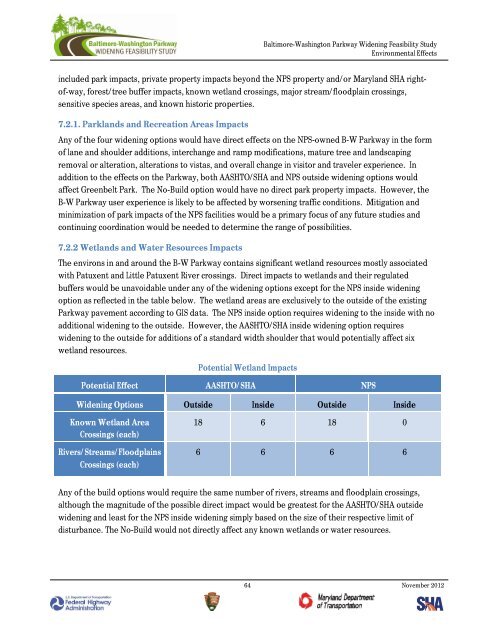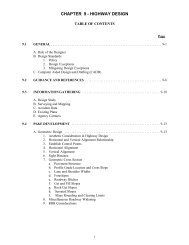Baltimore-Washington Parkway Widening Feasibility Study
Baltimore-Washington Parkway Widening Feasibility Study
Baltimore-Washington Parkway Widening Feasibility Study
- No tags were found...
You also want an ePaper? Increase the reach of your titles
YUMPU automatically turns print PDFs into web optimized ePapers that Google loves.
<strong>Baltimore</strong>-<strong>Washington</strong> <strong>Parkway</strong> <strong>Widening</strong> <strong>Feasibility</strong> <strong>Study</strong>Environmental Effectsincluded park impacts, private property impacts beyond the NPS property and/or Maryland SHA rightof-way,forest/tree buffer impacts, known wetland crossings, major stream/floodplain crossings,sensitive species areas, and known historic properties.7.2.1.ParklandsandRecreationAreasImpactsAny of the four widening options would have direct effects on the NPS-owned B-W <strong>Parkway</strong> in the formof lane and shoulder additions, interchange and ramp modifications, mature tree and landscapingremoval or alteration, alterations to vistas, and overall change in visitor and traveler experience. Inaddition to the effects on the <strong>Parkway</strong>, both AASHTO/SHA and NPS outside widening options wouldaffect Greenbelt Park. The No-Build option would have no direct park property impacts. However, theB-W <strong>Parkway</strong> user experience is likely to be affected by worsening traffic conditions. Mitigation andminimization of park impacts of the NPS facilities would be a primary focus of any future studies andcontinuing coordination would be needed to determine the range of possibilities.7.2.2WetlandsandWaterResourcesImpactsThe environs in and around the B-W <strong>Parkway</strong> contains significant wetland resources mostly associatedwith Patuxent and Little Patuxent River crossings. Direct impacts to wetlands and their regulatedbuffers would be unavoidable under any of the widening options except for the NPS inside wideningoption as reflected in the table below. The wetland areas are exclusively to the outside of the existing<strong>Parkway</strong> pavement according to GIS data. The NPS inside option requires widening to the inside with noadditional widening to the outside. However, the AASHTO/SHA inside widening option requireswidening to the outside for additions of a standard width shoulder that would potentially affect sixwetland resources.Potential Wetland ImpactsPotential Effect AASHTO/SHA NPS<strong>Widening</strong> Options Outside Inside Outside InsideKnown Wetland AreaCrossings (each)Rivers/Streams/FloodplainsCrossings (each)18 6 18 06 6 6 6Any of the build options would require the same number of rivers, streams and floodplain crossings,although the magnitude of the possible direct impact would be greatest for the AASHTO/SHA outsidewidening and least for the NPS inside widening simply based on the size of their respective limit ofdisturbance. The No-Build would not directly affect any known wetlands or water resources.64 November 2012
















